the history of yeovil's pubs
PUBS HOME PAGE |
PUBS INTRODUCTION |
PUBS BY NAME |
BEERHOUSES |
white lion inn
10 Kingston
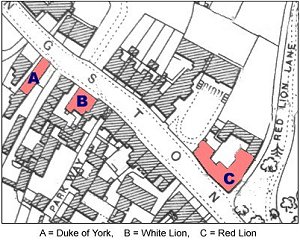 The
White Lion was
the symbol of
King Edward IV
(1442-1483).
The
White Lion was
the symbol of
King Edward IV
(1442-1483).
The White Lion Inn was a two-bay, two-storey brick built building with a one-bay gable facing Kingston.
It was located just along from the Duke of York and not too distant from the Red Lion Inn, all three of which are shown on the map at left.
The White Lion building seen in the photographs below was not the original building and probably dated to the 1890s. In March 1930 the Western Gazette published a contribution from a Yeovilian signing himself 'Ivel' in which he described parts of Kingston of the 1880s, in which he wrote "Fifty years ago the White Lion Inn and adjoining shop were a long, low thatched roof building. In those bygone days a thatched roof was a very common sight."
![]()
The first named licensee, George Chaffin, was born about 1807 in Somerset and in the 1841 census was living in Kingston with his wife, Ann, and their son John. George's occupation was given as a baker, but he and Ann may have been running the White Lion as a beerhouse although it isn't clear from the census. In 1842, however, Pigot's Directory listed him as the licensee and the Tithe Apportionment of 1846 lists him as the occupier with John Tanner Pitcher as the owner. In the 1851 census Ann was living in Hendford with her son George and his family and although Ann was described as married there was no sign of her husband. I lost track of them after that although there was a master baker called George Chaffin living in Taunton with his wife Mary in the 1861 census.
I've said elsewhere on this website that it was common practice for a man to carry on his trade during the day and for his wife to run the beerhouse or pub during the day and Thomas and Sabina Woolmington were a case in point - Sabina was listed as a beer house keeper in the 1851 census while he was listed as a glove leather parer but he was listed as a beer retailer in Slater's 1852 Directory. Thomas was born in Yeovil about 1812 the son of Yeovil-born servant, Thomas Woolminton, and Sabina Fox was born in Milborne Port around 1809. They were married in October 1840 in Yeovil and in the 1851 census were living in the White Lion with Thomas' father. As stated above, Sabina was listed as the beer house keeper and Thomas' occupation was listed as glove leather parer. Thomas was still listed as licensee of the White Lion in Harrison, Hodder & Co's 1859 Directory. However Thomas was probably in poor health as by the time of the census in April 1861 he was listed as a retired innkeeper, aged 48, and he and Sabina were living in Wellington Street. He died two months after the census, in June 1861. Sabina died on 27 September 1863, aged 54, leaving an estate of 'less than £100'.
James Edwards was born about 1836 at Hermitage (in the middle of nowhere), Dorset, some ten miles southeast of Yeovil. He married Elizabeth in July 1859 in Yeovil and by the time of the 1861 census James, Elizabeth and their baby son, Robert, were living at the White Lion Inn where, at the age of 25, James' occupation was listed as innkeeper. Unfortunately because James Edwards was such a common name, there were at least six in Yeovil at the time, I couldn't trace him any further with certainty.
The next licensee, Hugh Champ, was born around 1818 at Haselbury Plucknett. He married in April 1841 in Yeovil and in the 1841 census that was taken two months later showed him and his new wife, Prudence, living at Houndstone, Yeovil. He was listed as an agricultural labourer and she as a glove sewer. By 1851 Hugh and Prudence were living in one of the small houses in Back Kingston, still with the same occupations, but they now had three daughters; Eliza, Prudence and Elizabeth. Conditions must have been cramped as there were seven other people living in the same house. In the 1861 census Hugh's occupation was given as contractor's labourer and his family, now increased with a son, Hugh, and another daughter, Sophia, were listed as living in Moore's Cottages, Back Kingston. Moore's Cottages were opposite Pitney House, the residence of former solicitor, Mr T Moore. By 1866 Hugh was listed as licensee of the White Lion in Kelly's Directory and in the 1861 census, now aged 54, he was listed as labourer and innkeeper, living with Prudence and their daughter Spease. Hugh died in December 1873 even though Kelly's Directory of 1875 listed him as the White Lion's licensee. In October 1879 Hugh and Prudence's daughter, Spease, married Nathaniel Pinkard. In fact Prudence assumed the license on Hugh's death and she is listed as as beer house keeper in the 1881 census although the pub was mistakenly called the Red Lion in the census. Prudence was listed as the licensee in Whitby's Yeovil Almanack Advertiser of 1882 but she died, aged 65, in 1884.
The next licensee was Nathaniel Pinkard or Pinkett who, as mentioned above, was married to Hugh and Prudence's daughter, Spease. Nathaniel was born in Mudford Sock, just north of Yeovil, around 1846 the son of Robert Pinkett and his wife, Ann. In the 1851 census Robert was listed as a shoe maker and Ann as a shoe binder. Nathaniel lived with his parents and four older siblings; Samuel, Triphena, Alfred and Herbert, in Mudford Sock. By 1861 his father had died and Nathaniel lived with his mother, now a school mistress, and two older brothers. By 1871 Ann, Alfred and Nathaniel had moved to Mudford Road, Yeovil and the census listed Nathaniel as a County Court bailiff, by now aged 27. As mentioned above, in October 1879 he married Spease, the daughter of Hugh and Prudence Champ and by 1881 Nathaniel, Spease and one-year old twins, Alice and Frank, were living at 6 Union Street. Nathaniel was still employed as the County Court bailiff. After the death of Prudence in 1884, and certainly by 1889 when he was listed in Kelly's Directory, Nathaniel and Spease were running the White Horse - presumably she by day and he in the evenings. The 1891 census listed Nathaniel as County Court bailiff and inn keeper and as well as Spease and the twins there were three more children; Ellen, Rose and Robert. Nathaniel died in the winter of 1891 aged about 46 and after his death Spease briefly assumed the licence until May 1892. Spease died in the summer of 1895 aged just 37.
James Larcombe was born around 1836 at Yarcombe, Dorset, the son of labourer John Larcombe and his wife, Elizabeth, known as Betty. In the 1841 census James was living at Chardstock with his parents and four siblings. By 1851 his father had died and, at the age of fifteen he was working as an agricultural labourer to add to the family income. In October 1856 he married Elizabeth in Chard - difficult to say which one of the four Elizabeths married that month in Chard was 'our' Elizabeth, but she was born in Tatworth, near Chard. They lived in Tatworth for a few years where their son, George, was born and then in Farmborough, Somerset, where daughter Alice Maddalena was born. By 1861 James, Elizabeth and the children had moved to Chew Magna, Somerset, where James became a police constable. A son and a daughter were born at Chew Magna before a spell in Bridgwater, Somerset in the mid-1860's where another son was born. The family then moved to Wembdon, Somerset, where yet another son was born. James was still a police constable. Elizabeth died in 1880 and in the 1881 census policeman James and five of the children were still living in Wembdon. James remarried in Taunton in 1883 and in the 1891 census he and his Taunton-born wife, Jane Margaret, were living in Kiddles Lane (today's Eastland Road), Yeovil, with two of his children. James, now aged 56, was still a policeman but by 1895 Kelly's Directory was listing him as the licensee of the White Lion after a police career of some forty years. He was listed as the innkeeper of the White Lion in the 1901 census with Jane and daughter Emily, but had left the White Lion by 1903 when William Foale took over. The 1911 census found James and Jane living at 39a Orchard Street, Yeovil, he was described as a pensioner aged 76 and Jane was aged 69. They had been married for 28 years. Jane died in 1911 and James died in 1912.
William Foale was born in Dean Prior, Devon, (near Buckfastleigh on the southeastern edge of Dartmoor) in 1866 the son of agricultural labourer Robert Foale and his wife, Jane. In the 1871 census he was listed living in Dene Prior with his parents and three older siblings. In 1881 he was lodging in Cornwood, some eight miles west of Dean Prior, and working as a miller. In 1890 he married Alice Tarling in Cheltenham, Gloucestershire and by the time of the 1901 census he and Alice were living in West Hendford, Yeovil, with four children. William was working as a hotel porter but by 1903 Whitby's Yeovil Almanack Advertiser was listing him as the licensee of the White Lion. The licensee is referred to as C Foale in the 1907 Yeovil Directory but this is undoubtedly an error as in the 1911 census William is listed as a hotel porter and publican residing at 10 Kingston. Alice and their 16-year old daughter Ethel are both listed as assisting in the business - no doubt while William was working at his porter's job.
 After
this the records
get a bit
confusing as the
references below
indicating
William/Samuel
Foan as licensee
indicate.
Bearing in mind
that there was a
prominent Yeovil
Foan family in
the publican
trade I believe
that these
references are
mistakes and
actually refer
to William Foale
who, I believe,
remained as
licensee of the
White Lion until
his death in
1936. It was in
1936 that Oliver
Chainey took
over the license
for the next
twenty years.
After
this the records
get a bit
confusing as the
references below
indicating
William/Samuel
Foan as licensee
indicate.
Bearing in mind
that there was a
prominent Yeovil
Foan family in
the publican
trade I believe
that these
references are
mistakes and
actually refer
to William Foale
who, I believe,
remained as
licensee of the
White Lion until
his death in
1936. It was in
1936 that Oliver
Chainey took
over the license
for the next
twenty years.
gallery

An advertisement for the White Lion from Whitby's Yeovil Almanack Advertiser of 1910.
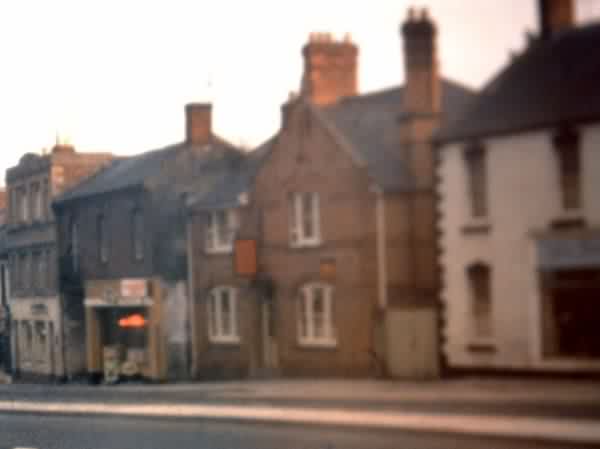
The White Lion, photographed in 1974.

Courtesy of
Dawn
Blackwell
The White Lion, at left, with the Duke of York at right.
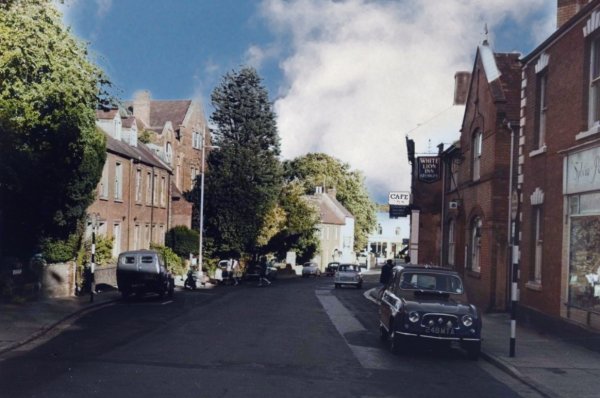
From the Cave
Collection
(colourised),
Courtesy of South Somerset Heritage Collection
The photograph above, taken around 1965, looks south down Kingston towards Princes Street and is taken from just about outside the Duke of York. Just behind the car at right is the White Lion with its sign visible above the car and at the end of the street the Red Lion stands in front of the last tree.
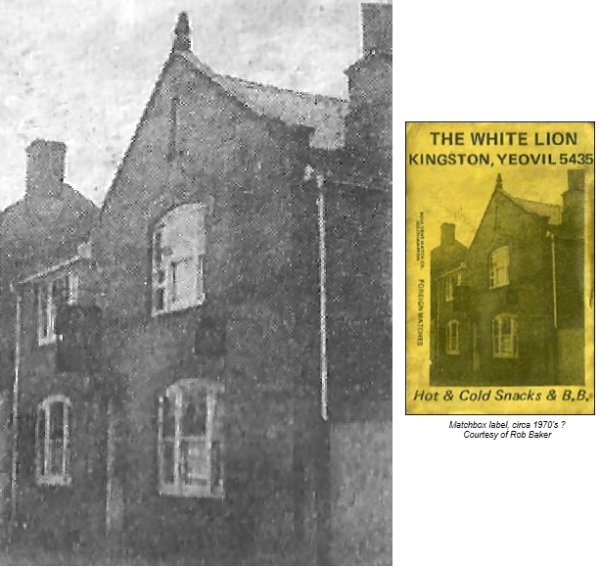
The photograph above left (apologies for the poor quality) is reproduced from the photograph on the matchbox label illustrated above right.
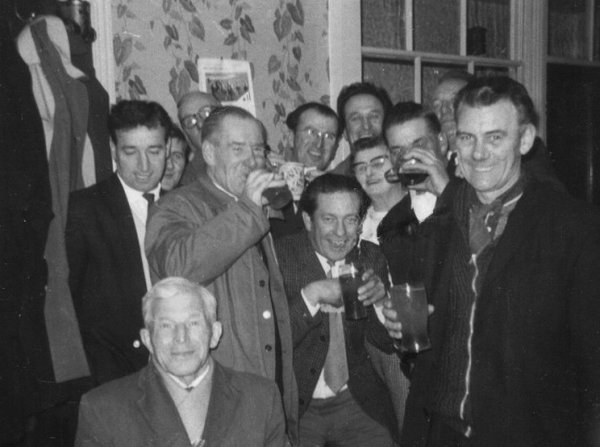
Regulars at the White Lion in the early 1960's. The landlady at the time, Annie, is seen in the centre of the photograph.

Courtesy of
Dawn
Blackwell
... and photographed during demolition.
licensees
1835 –
Licensee not
named (Robson's
1835 Somerset
Directory - Beer
Houses) White
Lion
1842 – George
Chiffin (Pigot’s
1842 Directory)
1846 – John
Tanner Pitcher,
Owner – George
Chaffin,
Occupier (Tithe
Apportionment:
291.
Inn,
Garden, etc.
Kingston)
1851 – Sabina
Woolmington –
Beer House
Keeper – (1851
census) pub not
named
1852 – Thomas
Woolmington –
Beer Retailer
(Slater's 1852
Directory)
listed as
Kingston
1859 – Thomas
Woolmington
(Harrison,
Hodder & Co 1859
Directory) as
White Lion,
Kingston
1860 – James
Edwards
– Spirit license
refused (Petty
Sessions)
1861 – James
Edwards – Inn
Keeper (1861
census) listed
as White Lion
Inn
1861 – James
Edwards – Beer
Retailer
(Kelly's 1861
Directory)
listed as
Kingston
1866 – Hugh
Champ – Beer
Retailer
(Kelly's 1866
Directory)
listed as
Kingston
1871 – Hugh
Champ – Labourer
& Innkeeper
(1871 census)
listed as White
Lion Inn
1872 – Hugh
Champ – Beer
Retailer and
Shopkeeper
(Kelly's 1872
Directory)
1875 – Hugh
Champ (Kelly's
1875 Directory)
listed as
Kingston
1881 – Prudence
Champ (62 year
old widow of
Hugh above) –
Beer House
Keeper (1881
census)
mistakenly
listed as Red
Lion
1882 – Mrs
Prudence Champ
(Whitby's 1882
Yeovil Almanack
Advertiser)
listed as White
Lion,
10 Kingston
1889 – Nathaniel
Pinkett – Beer
Retailer
(Kelly’s 1889
Directory) pub
not named
1891 – Nathaniel
Pinkard – County
Court Bailiff &
Inn Keeper (1891
census) as White
Lion Inn
1892 – Mrs
Spease Pinkett,
widow of
Nathaniel –
license transfer
(Borough Petty
Sessions, Jan)
1892 – James
Larcombe –
license transfer
(Borough Petty
Sessions, May)
1895 – James
Larcombe – Beer
Retailer
(Kelly’s 1895
Directory) pub
not named
1897 – James
Larcombe – Beer
Retailer
(Kelly’s 1897
Directory) pub
not named
1900 – James
Larcombe
(Whitby's 1900
Yeovil Almanack
Advertiser)
1901 – James
Larcombe – Inn
Keeper (1901
census) pub not
named.
1903 – William
Foale (Whitby's
1903 Yeovil
Almanack
Advertiser)
1907 – C Foale
(1907 Yeovil
Directory)
1911 – William
Foale – Hotel
Porter &
Publican (1911
census) as White
Lion Inn in
summary
1914 – Samuel
Foan – Beer
Retailer
(Kelly’s 1914
Directory) pub
not named
1915 – SW Foan
(Whitby's 1915
Yeovil Almanack
Advertiser)
1919 – William
Samuel Foan
(Kelly’s 1919
Directory)
1923 – Samuel
Foan – Beer
Retailer
(Kelly’s 1923
Directory) pub
not named
1936 – O Chainey
(1936 Yeovil
Directory)
listed as White
Lion
1939 – Oliver
Chainey (Kelly’s
1939 Directory)
listed as White
Lion Inn
1947 – O Chainey
(1947 Yeovil
Directory)
listed as White
Lion
1949 – O Chainey
(Kelly’s 1949
Directory)
listed as White
Lion
1951 – O Chainey
(1951 Yeovil
Directory)
listed as White
Lion
1954 – O Chainey
(1954 Yeovil
Directory)
listed as White
Lion
1957 – A
Jennings (1957
Yeovil
Directory)
listed as White
Lion
1960 – A
Jennings (1960
Yeovil
Directory)
listed as White
Lion
1965 – Licensee
not named (1965
Yeovil
Directory)
listed as White
Lion
1968 – Licensee
not named
(Kelly’s 1968
Directory)
listed as White
Lion
1969 – Licensee
not named
(Kelly’s 1969
Directory)
listed as White
Lion
1970 – Licensee
not named
(Kelly’s 1970
Directory)
listed as White
Lion
1971 – Licensee
not named
(Kelly’s 1971
Directory)
listed as White
Lion
1972 – Licensee
not named
(Kelly’s 1972
Directory)
listed as White
Lion
1973 – Licensee
not named
(Kelly’s 1973
Directory)
listed as White
Lion
1974 – Licensee
not named (1974
Yeovil
Directory)
listed as White
Lion